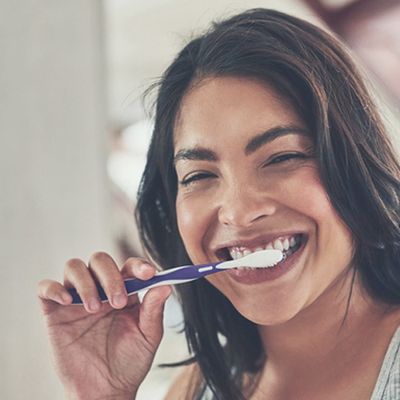
How To Clean Your Teeth Properly
So, what’s the best way to brush your teeth?
There are many good techniques for brushing your teeth, but a systematic approach usually works best as it ensures that you don’t miss a spot. Divide the mouth into four quarters: upper right, upper left, lower right and lower left. Work through each quarter, start by brushing the outside surface nearest the cheek, then the inside surface near the palate or tongue, and then the brushing surface on top of the teeth. Always brush right between the gums and the teeth, not just the teeth themselves.
Can you damage your teeth from brushing incorrectly?
Gum disease and tooth decay can both result from ineffective brushing, as you won’t be removing the bugs and plaque which can cause these diseases. Bad breath could also develop if the teeth and tongue are not kept clean.
Are there any tell-tale signs that you're not brushing properly?
A clear plaque film will form over the teeth within 12-24 hours if teeth are not brushed, which will make teeth appear yellow and feel ‘furry’ or ‘sticky’. The gums may also appear red and bleed very easily. Bleeding gums are a sign that you need to increase the frequency or effectiveness of your brushing and flossing regime.
There’s a lot of controversy about brushing your tongue, what’s your view?
Your tongue can harbour plenty of bugs and bacteria and it’s important that it is scraped or brushed regularly to avoid a buildup, which can cause bad breath and unbalance the flora in the oral environment.
Are there any parts of the mouth that are often overlooked?
The back of the lower teeth is always a neglected area as people often find this hard to reach. This area is especially important as its where one of the big salivary glands opens, so there is a high content of mineral saliva in this location and therefore tartar (yellow or brown stains on the teeth) tends to build up very easily.
How can you best clean in between your teeth?
Floss is ideal if you have small gaps between the teeth. Interdental brushes are better for larger gaps. You must make sure you have the right size interdental brush that fits snugly in the gap. The proper technique to use is to insert the brush into the gap, turn it like a key and then take it out.
What’s the correct way to floss?
Floss is best used to scrape up each side of the teeth to remove bugs that trap in between - next time you visit your dentist, get them to show you the best technique either on a model or inside your mouth.
Are electric toothbrushes much better for your teeth than a regular toothbrush?
Evidence suggests that you can clean your teeth just as well with a manual or electric toothbrush, but the electric toothbrush makes it easier and it doesn’t require you to be as manually dexterous as a manual, so it can make things much easier.
When is it best to brush your teeth?
Always brush your teeth before breakfast as it supplies your teeth with fluoride in advance of your breakfast sugar intake, which will help protect the teeth against developing cavities. Never brush your teeth after something acidic like citrus fruits, as the acid in the fruit will make the teeth soft and brushing at this time could remove the enamel. Wait at least an hour after something acidic before brushing.
Is it essential to use a mouthwash?
Mouthwash is a good tool to give a quick fluoride boost after eating a snack or lunch but should not be used directly after brushing your teeth, as it will wash away all the strong medicine in the toothpaste which is designed to protect against dental cavities and preserve gum health.
Is it best to rinse the toothpaste using water or skip that bit?
Never rinse your mouth after brushing your teeth as all the good toothpaste will go straight down the plug hole and not give your teeth the benefit they need.
What ingredients make a good toothpaste?
Fluoride is the main, most important ingredient. For adults the concentration should be at least 1450ppm.
Are whitening products as bad as they say? Can you recommend any good ones?
The best way to whiten your teeth is with professional dentist bleaching. Toothpastes can’t legally contain any bleach, so they are really just stain removers rather than true whiteners, and sometimes the ingredients are not so effective at keeping teeth healthy.
For more information on dental care, visit WhiteSwanAesthetics.co.uk
DISCLAIMER: We endeavour to always credit the correct original source of every image we use. If you think a credit may be incorrect, please contact us at info@sheerluxe.com.